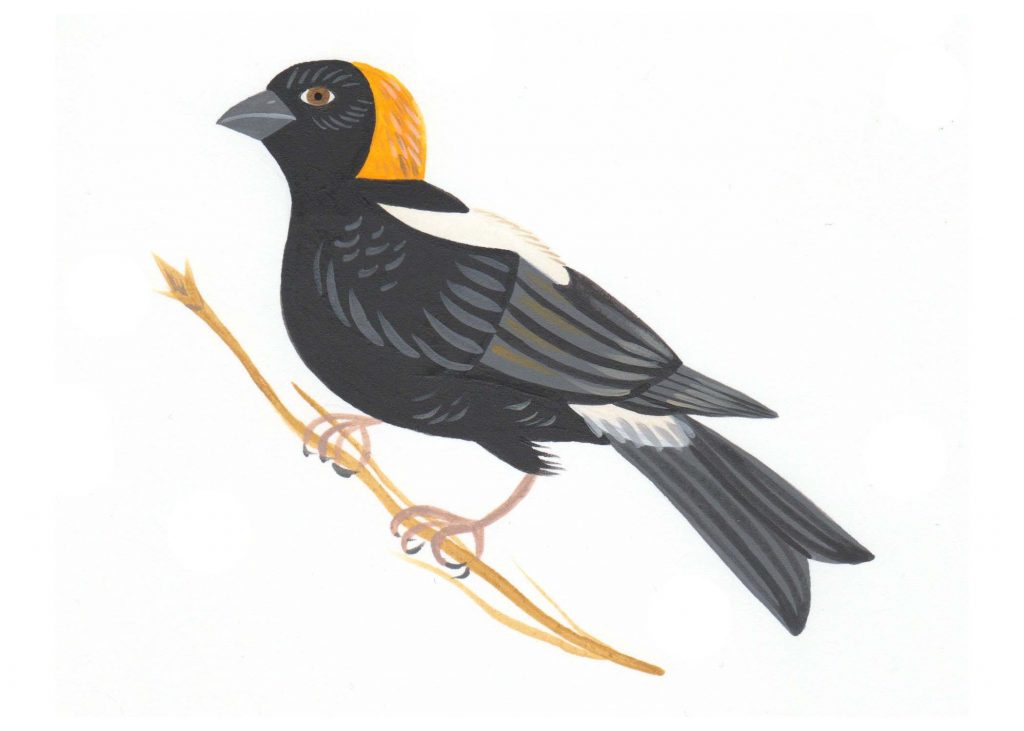“The aim of art is to represent not the outward appearance of things, but their inward significance.”
– Aristotle
Every living being has a story to tell. As an artist and nature enthusiast, Lisa Vanin tells the stories of the natural world through her art. Her unique art style transports her audience to a world where folk art and fine art collide. Lisa’s paintings of Ontario’s at-risk species remind us of their beauty and vulnerability, and that we all have a role in helping them fight for their survival.
Blanding’s Turtle: Threatened Provincially, Endangered Nationally

Did you know that all native Ontario turtles are now at risk? While it is easy to identify a Blanding’s turtle by its distinctive bright yellow chin and throat, threats such as wetland habitat loss, vehicle collisions and nest predation are driving their decline, making them harder to spot in the wild.
Turtle road mortality is generally the highest in May, June and July, as they travel to find a mate once the weather warms up. Some female turtles are found crossing roads to reach nesting sites, while others lay eggs in the gravelly substrates on road shoulders. It is therefore important to always be aware of your surroundings while driving. Wildlife warning signs can often be found in turtle hotspots. If you see turtles crossing the road, help move them in the direction they are travelling, if it is safe to do so.
Bobolink: Threatened Provincially and Nationally

Bobolinks are among the very few bird species that undergo two complete molts per year. Every summer, breeding males distinguish themselves from females by molting into their sleek black plumage, accessorized with a yellow head patch and bold white patterns down their back. Afterwards, they molt back into a striped, brown plumage, disguising themselves among the females.
The bobolink’s population in Ontario has decreased by 75 percent in the past 50 years. The population is expected to decline further due to the continued habitat loss and degradation, incidental mortality (e.g. hay mowing during breeding season) and hostile wintering grounds.
Eastern Loggerhead Shrike: Endangered Provincially and Nationally

A disproportionately large head has given this fearsome predatory songbird its common name. Despite their draconian feeding behaviour, eastern loggerhead shrikes are losing their habitats not only to development, but also to vegetation succession, when thickets and shrubs creep in to take over the unmanaged grasslands. Road mortality and toxic prey ingestion pose threats to their survival as well.
Boreal Caribou: Threatened Provincially and Nationally

Boreal caribou are among the most elusive and majestic of North America’s big mammals. They rely heavily on mature conifer forests to avoid predators and to forage. With rapid human developments and activities such as industrial logging, caribous are losing their habitats. The situation is worsened with the provincial government prioritizing profit over wildlife protection.
Ontario Nature will continue to protect boreal caribou’s critical habitat through conducting research and holding stakeholders accountable in forest management. We have recently partnered with Birds Canada to evaluate the conservation value of the Forest Stewardship Council (FSC) candidate protected areas and to make the case for their need for permanent protection. Those areas include significant boreal caribou habitat.
Redside Dace: Endangered Provincially and Nationally

In Canada, Redside dace is found only in southern Ontario. Males are more intensely coloured than females, with red and yellow stripes along the body. Their vibrant colours intensify during spawning seasons. Riparian vegetation loss, altered stream flow and changes in water temperature caused by nearby developments threaten their habitats.
Rusty-Patched Bumblebees: Endangered Provincially and Nationally

With a particularly short tongue, the rusty-patched bumble bees feed by puncturing flowers to suck up the nectar. Although once abundant, the species population has declined by 90 percent throughout its range. Some of the factors that contribute to the decline of Canadian native bees are pesticide use, disease spillover, habitat loss and climate change.
Monarch Butterfly: Special Concern Provincially and Nationally

The iconic monarch butterfly serves as a reminder of the importance of public engagement in wildlife conservation. From caterpillar rearing to planting milkweed in the backyard, nature lovers have put tremendous effort into saving these legendary migrants, which are threatened by habitat loss, pesticide use and climate change. Learn more about how to re-wild your property to help Ontario’s wildlife and native pollinators in our summer 2021 issue of ON Nature magazine.
The post Seven Ontario Species at Risk Through the Eyes of an Artist appeared first on Ontario Nature.

